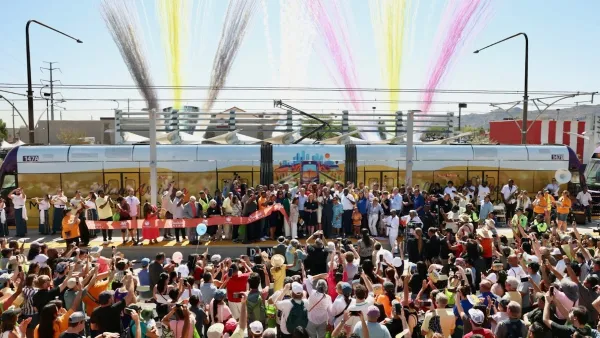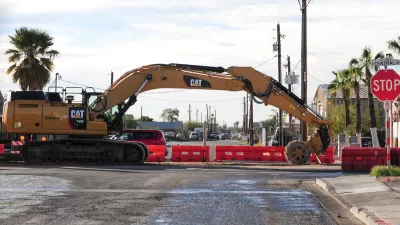A seven-year-old light rail line has beaten ridership projections and transformed neighborhoods in Phoenix. Now, one of the nation's most sprawling cities considers where to expand the system—and how to pay for it.

In a risky move for a mayor in a largely conservative state, Phoenix Mayor Greg Stanton is asking voters to approve a 35-year sales tax increase. He's promising big, tangible returns: funds will contribute to the expansion of Phoenix's light rail system, which currently measures 20 miles, with a 3-mile extension into Mesa underway. Stanton is pushing expansion in the face of what many consider the line's overwhelming success.
"Today passengers take nearly 44,000 trips on light rail on a typical weekday, already beating the local transit agency’s estimates for ridership in 2020. Long-neglected neighborhoods are experiencing new life, and major employers credit transit for their decision to add new jobs in the region."
"(Mayor Greg) Stanton argues that the strategy has worked so well that it should be rolled out to many more neighborhoods. 'It’s about more than getting people from point A to point B. The single most powerful tools we have to drive economic development are quality streets and robust public transit,' Stanton said while pitching his new transportation plan this spring. He argued that the increased rider capacity would help prepare Phoenix for further population growth and link more of the area’s community colleges and universities. 'It is the most comprehensive transportation plan in our city’s history,” he said. 'It’s forward-thinking. It’s ambitious. And the city council and I will ask voters to approve this plan in August.'"
Planners seem to have picked a good route to lure Phoenix residents out of their cars—and to attract those who don't have cars in the first place. Arizona State University contributes a large number of riders. Many have also discovered the line en route to events downtown. As well, at least one major company has relocated downtown, and local government has accounted for much of the new development along the line.
"Sports events are a major draw for light rail passengers, and downtown sports facilities, built well before the light rail, represent another huge public investment. Chase Field, where the Arizona Diamondbacks play baseball, was built using sales tax revenues and is owned by Maricopa County; U.S. Airways Center, home of the Phoenix Suns basketball team, is owned by the city. Meanwhile, the city-owned Sky Harbor Airport, which draws 31,000 employees along with airline passengers, is improving the connection between the airport rail station and its terminals with a new $1.6 billion automated train."
While light rail still rouses critics who say it is too expensive, those objections have quieted somewhat.
"Light rail is not nearly as controversial in Phoenix as it was a decade or so ago, when several ballot measures to fund it were defeated. “There was a loud roar back in the early 2000s” when it was being proposed, says Todd Sanders, the president and CEO of the Greater Phoenix Chamber of Commerce. 'Today you really don’t hear it. More and more you hear people wanting to get light rail, in the next phase, into their communities.'"
FULL STORY: How Car-Centric Cities Like Phoenix Learned to Love Light Rail

Planetizen Federal Action Tracker
A weekly monitor of how Trump’s orders and actions are impacting planners and planning in America.

Maui's Vacation Rental Debate Turns Ugly
Verbal attacks, misinformation campaigns and fistfights plague a high-stakes debate to convert thousands of vacation rentals into long-term housing.

San Francisco Suspends Traffic Calming Amidst Record Deaths
Citing “a challenging fiscal landscape,” the city will cease the program on the heels of 42 traffic deaths, including 24 pedestrians.

Defunct Pittsburgh Power Plant to Become Residential Tower
A decommissioned steam heat plant will be redeveloped into almost 100 affordable housing units.

Trump Prompts Restructuring of Transportation Research Board in “Unprecedented Overreach”
The TRB has eliminated more than half of its committees including those focused on climate, equity, and cities.

Amtrak Rolls Out New Orleans to Alabama “Mardi Gras” Train
The new service will operate morning and evening departures between Mobile and New Orleans.
Urban Design for Planners 1: Software Tools
This six-course series explores essential urban design concepts using open source software and equips planners with the tools they need to participate fully in the urban design process.
Planning for Universal Design
Learn the tools for implementing Universal Design in planning regulations.
Heyer Gruel & Associates PA
JM Goldson LLC
Custer County Colorado
City of Camden Redevelopment Agency
City of Astoria
Transportation Research & Education Center (TREC) at Portland State University
Jefferson Parish Government
Camden Redevelopment Agency
City of Claremont





























